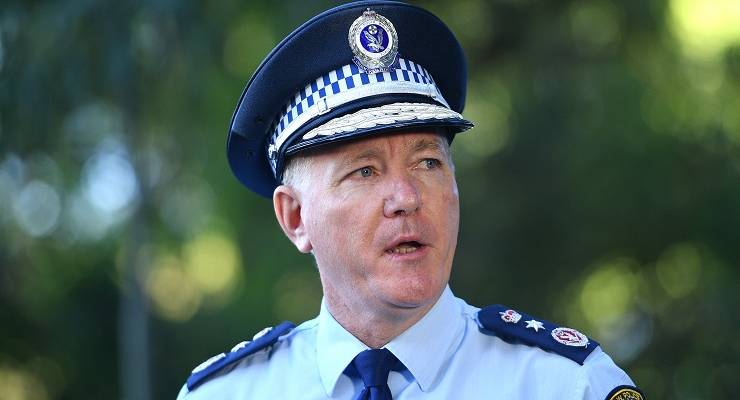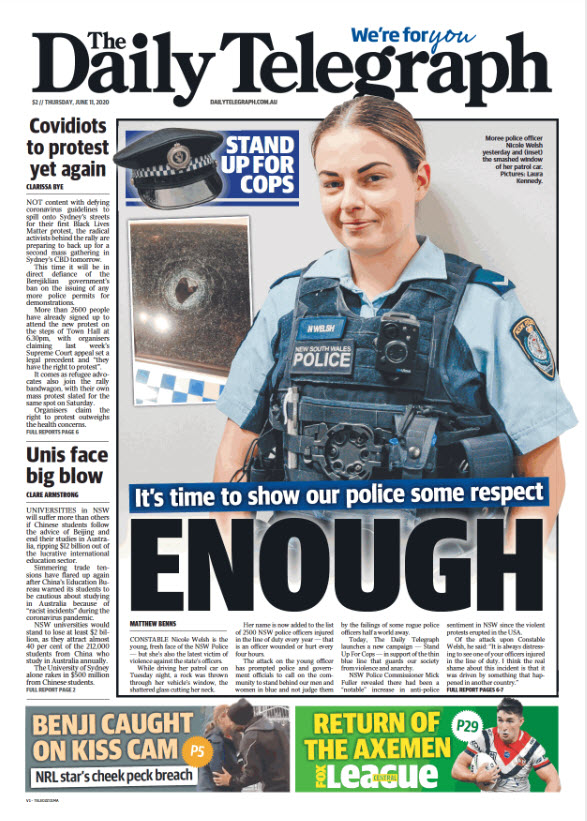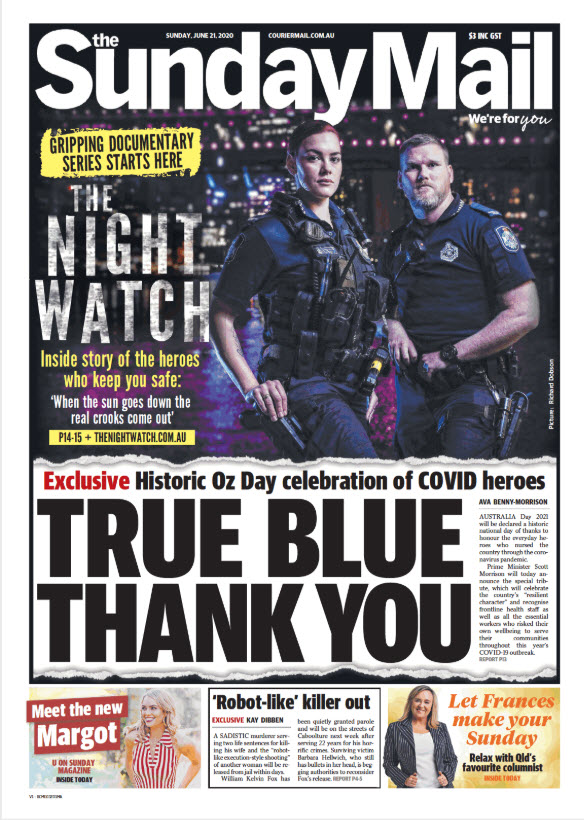
In the weeks since Minneapolis police officers killed George Floyd, the cultural shift in America has been swift. The TV show Cops was pulled off the air after 32 years. Police abolition, once a far-left pipe-dream, is now an argument given a serious run by establishment outlets like The New York Times. And there’s been a seismic change in public opinion, both on Black Lives Matter and attitudes to the police.
But in Australia, where our public discourse so often swims downstream from the United States, sympathetic media outlets have quickly tried to blunt that narrative shift. Since protests around the country drew thousands, and pushed the issue of black deaths in custody back into the spotlight, Australia’s tabloid media has been awash with defensive, pro-police content.
Tabloids say Blue Lives Matter
Just days after protests began to swell across American, footage of police in Sydney aggressively slamming an Indigenous teenager into the ground went viral. The next morning, NSW Police Commissioner Mick Fuller discussed the arrest with 2GB’s Ben Fordham, Alan Jones’ heir to the Sydney talk radio throne.
Both Fordham and Fuller pointed out that the boy had used bad language toward the officer.
“I would imagine there’s people who would say ‘well you can’t just go around swearing at police and threatening them either’,” Fuller said.
Fordham would continue to return to the trope of police officers under siege in coming weeks. Stories about attacks on police officers get a run nearly every day. There was a call from a distraught father, who said his police officer son felt “victimised” by the protests and the sharp criticism of cops. This morning, Fordham began the week with Fuller again, with the pair linking the protests around the world with a rise in attacks on cops in Australia, and calling for mandatory minimum sentences for violence against police.
But the pro-police narrative was prosecuted most aggressively in Sydney’s The Daily Telegraph. A front page on June 11, which called for an end to violence against police, urged readers to “stand up for cops”.

In the accompanying story, Fuller warned against a rise in anti-police sentiment following the protests.
In another piece about an attack on an officer days later, the Tele credited it’s “stand up for cops campaign” with influencing the state government’s decision to commence a parliamentary inquiry into violence against police.
Other News Corp tabloids took up the narrative with zeal.

Last week, News kicked off its web series “The Night Watch”, which highlights the after-dark exploits of police and other emergency workers, described in breathless tones as Australia’s “every night heroes”. The series has been aggressively promoted on websites, front pages, and social media channels.

Why shifting the discourse matters
For many people, pro-police narratives are comforting. But according to University of Technology Sydney law professor Thalia Anthony, the way tabloid newspapers and shock jocks so often try to characterise police as victims can muddy the waters, and make it harder to have an honest conversation about Indigenous deaths in custody.
“The media response has been like that for decades — it’s really uninformed, and it’s really reactionary,” Anthony says.
“The focus on violence against police redirects us from seeing Aboriginal people as victims to seeing cops as victims. The plight of Indigenous people becomes overshadowed and dwarfed by the plight of the police.”
But there are longer-term structural forces that shape police coverage in the media that go well beyond News Corp and talk radio. University of Sydney criminology professor Murray Lee says most of the information published in newspapers on policing, justice and crime comes from police media units, with a clear agenda.
“You’ve got a lot of resources in state police organisations that are there working on the police image, curating, creating and compiling stories for the mainstream media.”
And as newsrooms continue to shrink, Lee suggests it’s far easier for journalists to simply fall back on a pre-written police press release.
Anthony also suggests Australia’s media “oligopoly” makes its harder for diverse, critical voices on police culture to cut through.
“It’s not sufficient to have the media run by so few people, especially when their interests align with the powerful.”
All up, cops get an overwhelmingly sympathetic run in the press, even though, as Lee points out, many individual officers feel the media treats them unfairly.
That coverage also seems to have helped cement perceptions around systemic racism and police brutality in Australia. A recent poll found that most Australians think there’s institutionalised racism in American police forces, but not back home.








There’s obviously institutional racism against First Nations people among police in Australia, though this does not mean that all police are racist, nor that the degree of racism does not vary by regions, with parts of the Northern Territory, northern Queensland and northern Western Australia and parts of our major cities with relatively high levels of racism. The level of racism among the Australian public is higher against aborigines than any other group. The NSW police commissioner reveals it in his comment about the boy who had his legs swept from under him during an arrest. With a white person abusing police, this would obviously be unnecessary force in the course of arrest but with the aboriginal boy, the question of unnecessary force does not arise: only the offence does. There is no need to feel surprised that the Murdoch media obviously spout propaganda on the issue. These media have primarily been organs for Murdoch approved propaganda for years and only secondarily report unvarnished news. The black lives matter marches in Australian cities would have been much larger if people had not felt some concern about Covid-19 infection. Australian police in a large number of places in Australia need to lift their game, if they want to look good.
Conservative press doing PR for a conservative (police) union? So?
My godson is a copper and he was brought up to repects everyone as no doubt were many others. We do not have the same issues as the US because we are not as trigger happy and philosophically our police are about prevention rather than enforcement. The US police forces were formed to control unions, blacks, disgruntled workers, to recapture slaves. They were not about community policing.
The loudmouth who would “Break your f ing jaw deserved a smack in the ear. The man being tasered though he was clearly under control was a disgraceful scene and that officer has no place in the system. My issue is that clearly the police expect no sanction for their misdeeds and their union does not serve the community well by supporting the unsupportable and insupportable. Thre are still racist coppers though and their are still bent ones. The union supports both kinds and should support neither.
“Blue lives matter” is the occasional reminder we don’t see criminals as ourselves, but as a group we need protection from. Cops thus get to decide who lives or dies and we cheer them on as they do so.
In a democracy we would be normally outraged by the State asserting that sort of power if we gave any thought to the victims being members of society. But we don’t, and so they are killed with our implicit blessing.
“But in Australia, … our public discourse so often swims downstream from the United States.”
How true. How often do we see “Black deaths in custody” named as the problem, in blind imitation of the USA.
In fact, aborigines don’t die disproportionately in custody, as both Insiders and The Guardian have quietly admitted (Insiders showed the statistics without comment, the Guardian said “But that’s not the point!”) I wish Crikey would too.
Not denying there have been shocking examples of police brutality, but the problem is just “Blacks in custody” – the disgracefully high number of aborigines who are in custody in the first place.
The number of Aboriginal prisoners who die in custody as a proportion of all Aboriginal prisoners is reported to be similar to the number of non-Aboriginal prisoners who die as a proportion of all non-Aboriginal prisoners. If you stop there the figures seem to support the “nothing to see here” response. But the number of Aboriginal prisoners as a proportion of the population is hugely disproportionate. That’s not because Aboriginal people are inclined to criminality. It’s at least partially because Aboriginal people are over-policed. Every Australian who looks Aboriginal knows what it is like to be stopped and questioned for no apparent reason. Every Australian who looks Aboriginal knows what it is like to be followed around in shops by store security. Aboriginal people, including children, are more likely to be prosecuted by police for something that would get a warning for a non-Aboriginal person. Then, already disproportionately prosecuted the Aboriginal accused, unlikely to have paid legal advice, is disproportionately likely to be sentenced to imprisonment. Until last week in WA fine defaulters, invariably poor people who can either eat food or pay their fines but not both, were imprisoned for unpaid fines. Some deaths in custody have been people jailed for fine default. Aboriginal deaths in custody are a problem because Aboriginal custody is a problem.
I think we agree.
We do. I’m going to contact my parliamentary representatives about it (again). I invite our Crikey comrades all to do so.
“In fact, aborigines don’t die disproportionately in custody“.
It’s true, but it’s false. Another statistic that buries the lead. They are incarcerated at roughly 40 times the white population, so their ‘proportionate’ deaths in custody are 40 times the white population.
And the trouble is that most people don’t understand statistics, so they don’t get that. Aboriginals are incarcerated for petty crimes, misdemeanours and just walking down the street. Rich white men can rob you of your superannuation investments, or charge dead people for no service and not one of them is charged let alone remanded.
…. Some of them can qualify for an AO.